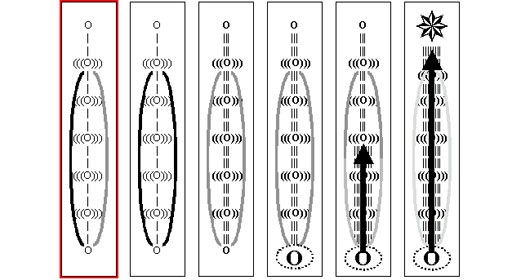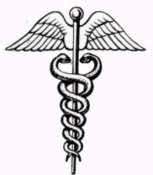#1: Prana normally flows in either Ida or Pingala: Our kundalini energy system is usually more active in either the left or right sides, which are the Ida and Pingala.

Of the thousands of energy channels (nadis), three are most important: Ida, Pingala, and Sushumna (sometimes called “silver cord”), which is the central channel, and the most important.
Solar and lunar breaths: The breath and the underlying energy, or Prana, usually flow predominantly on one side or other, the left or the right. Breath predominantly in the left nostril is described as cool, and sometimes referred to as feminine. The flow of Prana on the left is the lunar, and is called Ida. Breath flowing predominantly in the right nostril is described as hot, and sometimes referred to as masculine. The flow of Prana on the right is the solar, and is called Pingala.
Nostril dominance shifts: Usually we believe that we are breathing through both nostrils, although breath is normally dominant in one or the other. The dominance shifts from time to time during the day. For one with a well balanced body and mind, that shift of nostril dominance happens approximately once in ninety minutes. For other people, the shift may be much different. Sometimes one can be so off balance that one nostril remains dominant, which is a symptom of some physical, mental, or emotional difficulties.
Prana is the first energy: The word Prana comes from two roots. Pra means first, and na is the smallest unit of energy. Prana is therefore the first breath, the primal or atomic beginning of the flow of energy. Out of this first unit of energy manifests all aspects and levels of the human being. It is one and the same with kundalini shakti.
Prana flows in nadis: That kundalini, manifesting as Prana flows in certain patterns, or lines, or channels that are called nadis. There are said to be some 72,000 such nadis coursing through the subtle body that supports the physical body and its various systems. When the Prana flows across the latent impressions, they spring to life in the form of awareness in the conscious mind, in the physical body and brain.
Intersections of the nadis are chakras: When kundalini manifests outward, those thousands of nadis intersect here and there, forming the matrix of the subtle body. The major intersections are called chakras (section #5), and the five elements of earth, water, fire, air, and space manifest around these so as to form the gross body. Often, we speak of chakras as if they are in the body. Actually, this is somewhat backwards. It is more like the body has been suspended on the subtle chakras, with these chakras being formed or constructed by the major highway intersections of the nadis, which are none other than kundalini shakti.
|
Caduceus of medicine: The caduceus is the symbol of medicine. The root meaning of medicine or medicate means attention, which is also the root of meditation. Thus, we have attending physicians, and we pay attention in meditation. The caduceus is a winged staff, with two serpents, and is carried by the Greek god, Hermes, who is said to be the messenger of the Gods. Together, Ida and Pingala form the snakes of the caduceus, while Sushumna forms the staff. The snakes intersect at the chakras, as do the nadis described above. At the ajna chakra, between the eyebrows, there are two petals, one on either side, just as there are two wings at the top of the caduceus. Thus, the caduceus is a symbol of the entire system of kundalini shakti. |
Prana divides itself into five Vayus: When kundalini comes outward as Prana, the Prana operates in the body, it divides into five major flows called Vayus. These can be thought of as somewhat like major currents in one of the large oceans of the world, while there may be thousands of smaller currents. These five Vayus are the major currents that contain thousands of smaller currents.
-
Prana Vayu operates from the heart area, and is an upward flowing energy, having to do with vitalizing life forces.
-
Apana Vayu operates from the base of the torso, in the rectum area, is a downward flowing energy, and has to do with eliminating or throwing off what is no longer needed.
-
Samana Vayu operates from the navel area, deals with digestion, and allows the mental discrimination between useful and not useful thoughts.
-
Udana Vayu operates from the throat and drives exhalation, operating in conjunction with Prana Vayu, which deals with inhalation.
-
Vyana Vayu operates throughout the whole body, having no particular center, and is a coordinating energy throughout the various systems.
Reversing Prana and Apana Vayu: Most significant about the five Vayus are Prana vayu and Apana Vayu. As mentioned above, Prana Vayu is an upward flowing energy and Apana Vayu is a downward flowing energy. One of the ways of describing the process of intentional Kundalini Awakening is that these two energies are intentionally reversed through a variety of practices. Reversing the energy causes the Kundalini at the base of the subtle spine to awaken, and to begin to arise. Although this is not necessarily an easy thing to do, it is very useful to know that there is a basic simplicity to this process, that of reversing these two energy flows. (See also Yoga Sutras, particularly sutras 2.49-2.53 on pranayama.)
Prana drives the ten indriyas: Prana is the source of energy that operates the ten indriyas. Five are the karmendriyas or instruments of actions, which are elimination, procreation, motion, grasping and speaking. Five are the jnanendriyas or cognitive senses, which are smelling, tasting, seeing, touching, and hearing. These ten operate through the chakras, and receive their power from the Prana.
Read Process of Kundalini Awakening here…
Read Kundalini Awakening Part II Here
Read Kundalini Awakening Part III Here…
Read Kundalini Awakening Part IV…
Read Kundalini Awakening Part V Here…
Read Kundalini Awakening Part VI Here…









































